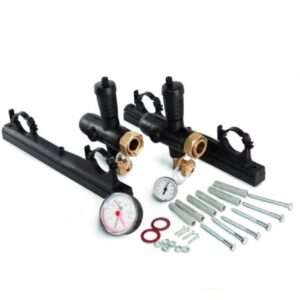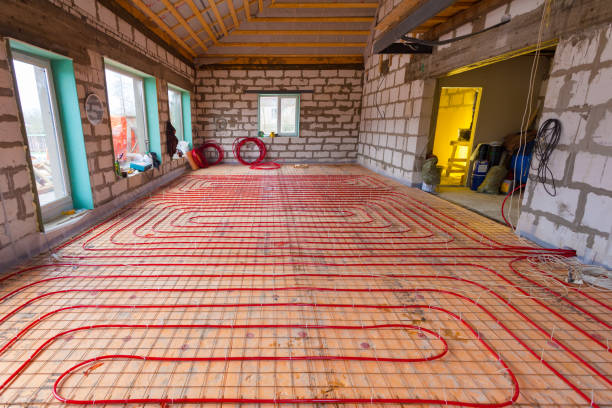Underground heating (UFH) systems are gaining in popularity in both new builds and renovated properties.
That’s because they’re highly energy efficient and convenient, creating a consistent temperature across the entire space.
Until something goes wrong.
After all, you don’t want to be sitting at home in the middle of December, freezing cold and wondering:
‘Why is my underfloor heating not working?’
At Clickbasin, we’ve put together a comprehensive guide exploring some of the most common underfloor heating problems, what to do about them, and how to repair underfloor heating and ensure its long-term performance.
Let’s dive right in.
Table of contents:
- How long does underfloor heating last?
- How to find a leak under the floor
- How to fix an underfloor heating leak
- How to repair electric underfloor heating
- Underfloor heating maintenance tips
- Final thoughts
How long does underfloor heating last?

One of the first questions homeowners ask when considering an underfloor heating system is how long it’s likely to last.
The thing is:
As long as they’re properly installed, maintained and serviced regularly, most wet underfloor heating systems have a fantastic lifespan of around 50 years. The corresponding figure for an electric system is 25 years.
What’s more:
Both types will retain their exceptional performance for the entire duration.
In contrast, your average radiator will start to become inefficient after about 10-12 years.
But what can you do to deal with some commonly found issues found in UFH?
That’s what we’re going to look at next.
How to find a leak under the floor
If you have a water-based system, you might have to deal with a leak or two down the road.
While less common than other plumbing leaks, underfloor heating leaks could potentially be caused by the following factors:
- Faulty installation of the system – your system should be installed by a professional in full accordance with the manufacturer’s instructions.
- Wear and tear – this is inevitable, and there’s nothing you can really do about it.
- Damaged pipes during construction work – construction and renovation work taking place after UFH has been fitted should be mindful of the system.
- Expanded pipes during freeze weather – if you live in a particularly cold area of the country, make sure your pipework doesn’t freeze during the winter.

Detecting UFH leaks can be a little tricky, as they’re typically out of site.
Still, there’s plenty you can do to find the specific location of your leak and then move on to repair underfloor heating.
Firstly, keep an eye out for damp areas on the floor. As soon as you see one, dry it thoroughly and check back the next day. If the location is wet again and the ceiling isn’t leaking, you’ll know it’s the underfloor heating. The same goes for mould or mildew build-up.
Secondly, check for cracks in wooden floors. Liquids will make the wood swell, creating an uneven surface and causing cracks.
Thirdly, look out for uneven temperatures. As we mentioned earlier, a consistent temperature across the entire room is one of the biggest benefits of UFH systems. So, if a specific part of your floor is seriously hotter than the surrounding area, it might be the result of hot water leaking there.
Finally, if all of the above fails and yet you still suspect you might have a leak (for instance, you keep hearing gurgling noises coming from the pipes), you can use thermal imaging. However, keep in mind that even the most basic thermal imaging cameras are very expensive.
So, unless you simply happen to have one lying around, we would recommend calling in the professionals.
How to fix an underfloor heating leak

Once you’ve successfully found the leak, start by switching off the water mains.
Then, proceed to remove the flooring around the location of the leak so you can get access to the pipe. The exact way to go about this will depend on the type of flooring you have and how it’s been laid in the first place. In any event, make sure you always follow the manufacturer’s instructions.
Depending on the extent of the damage, you can choose to fix it using either one of the following methods.
Method 1: Use self-amalgamating repair tape
Using self-amalgamating waterproof pipe repair tape is a great, quick way to fix smaller cracks in pipes. Made from self-fusing silicone, it’s easy to apply and (depending on the model) resistant to temperatures of up to 250°C- 260°C, making it ideal for use with wet UFH systems.
Simply wrap the tape around the crack and tighten it as much as possible to create a fully watertight seal.
Method 2: Use epoxy putty
If there’s a bigger hole in the pipe or simply not enough room for you to wrap tape all the way around, we recommend using epoxy putty instead. Often used as a space-filling adhesive, most epoxy putty available on the market comes in two separate parts, often coloured blue and yellow to distinguish them.
Once mixed and applied to the hole in the pipe, the putty will harden within an hour.
Finally, replace the flooring and switch the water mains back on.
How to repair electric underfloor heating
If you have an electric UFH system, the most common issue you’re likely to encounter is a damaged or broken underfloor heating mat cable. You’ll be able to tell that you have one because that particular area of the floor will be considerably cooler than the rest.
The good news is:
Repairing underfloor heating cables is reasonably easy with the help of a readily available underfloor heating repair kit. Once you’ve bought one of these handy kits, make sure you’ve switched off the heating. Then, remove the flooring in the affected area.
Now:
The exact sequence of steps will differ slightly from one manufacturer to the next.
However, the general process involves removing the damaged section of the cable and the surrounding insulation before bridging the heating element with jump wires.
Next:
You would normally connect the earth jumper cable to the metal earth screens and affix the heat shrink tube (or similar, as provided) over the new section.
Keep in mind that one cable repair kit will fix one damaged section only. So, if you have three damaged sections, for instance, you’re going to need three kits to get the whole job done in one go.
Underfloor heating maintenance tips
A bit of regular underfloor heating troubleshooting can go a long way towards keeping your underfloor heating system in good working order and prolonging its lifespan.
Having said that, here are our top tips:
Firstly, don’t forget to service your underfloor heating system once a year. This will allow for any potential issues to be identified and fixed early on before they can cause any extensive damage that will require costly repairs.
Secondly, bleed your UFH when necessary. Check out our handy guide to find out more about when and how to go about bleeding underfloor heating.
Thirdly, be careful when doing construction or repair work so as not to damage your underfloor heating pipes.
Fourthly, do not delay when repairing underfloor heating is necessary.
Final thoughts
Most underfloor heating systems are light on maintenance.
So, as long as you have yours serviced regularly and follow our easy maintenance tips, you shouldn’t have to face any major issues for many years to come.
And if you have to deal with a leak on your wet UFH or a damaged cable on your electric UFH, you’re now well prepared to repair underfloor heating thanks to our guide.
We have every confidence that you’ll now be well-informed on repairing and maintaining your underfloor heating.




